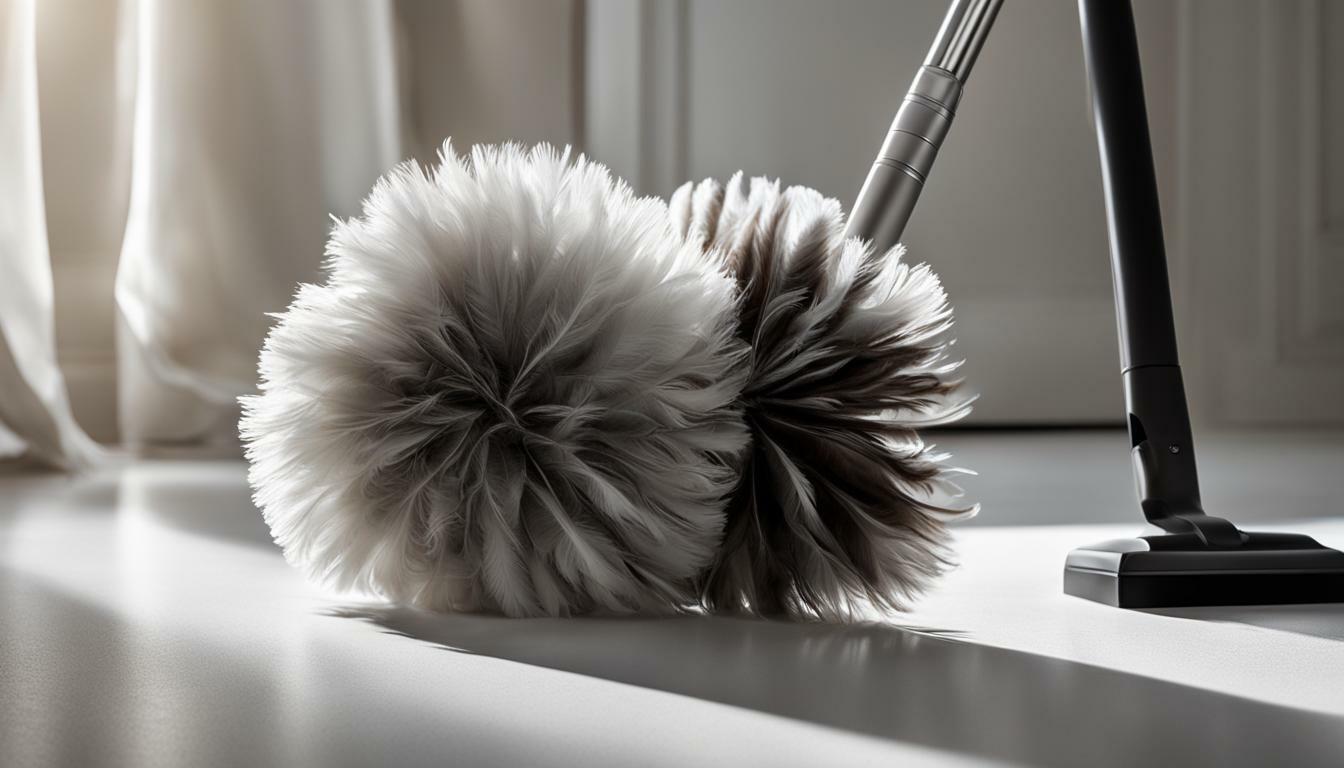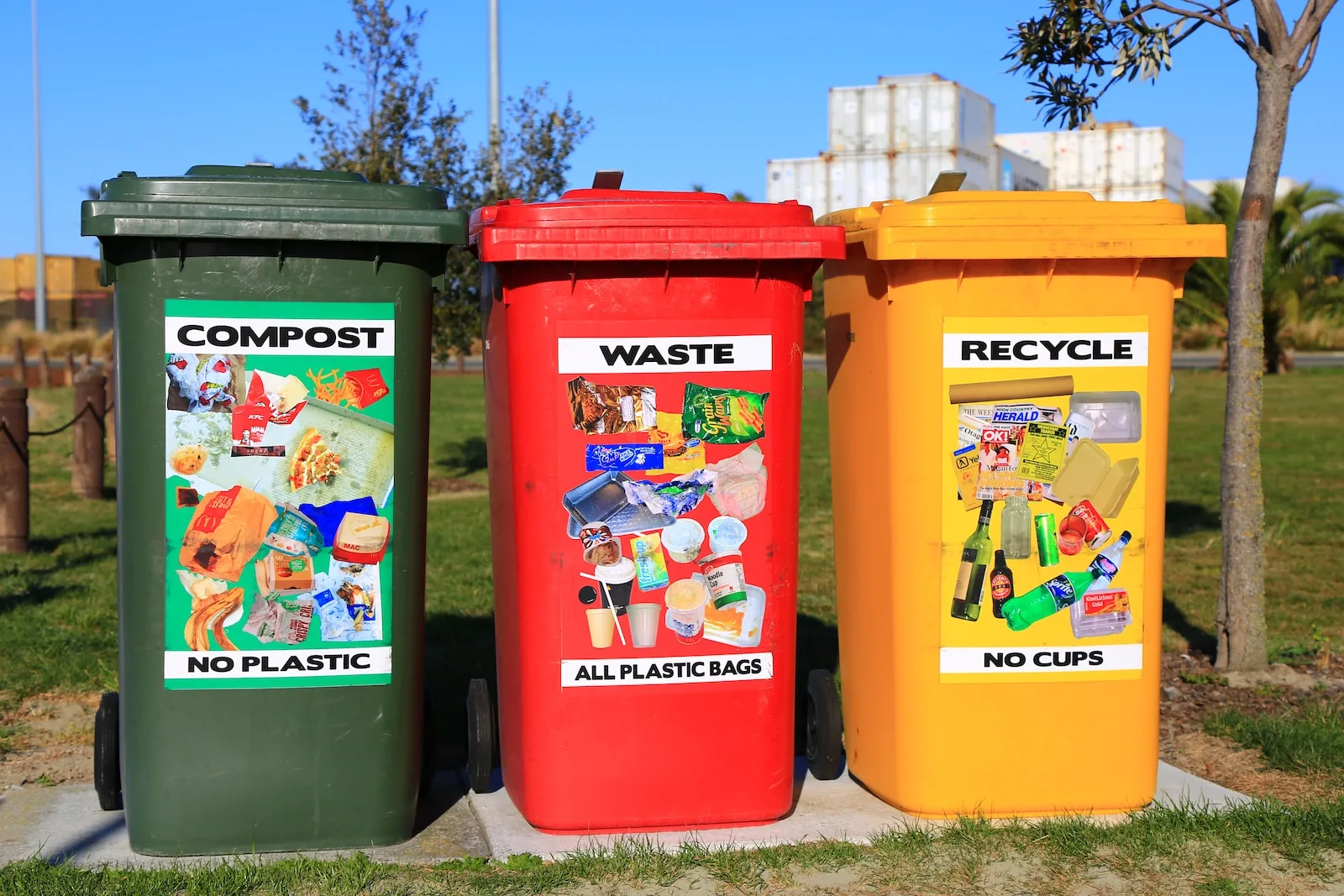Keeping your home or workspace clean is no easy feat, and dusting is one of the most essential tasks in any cleaning routine. The right dusting tool can make all the difference in how effectively you clean and how much time you spend doing it. But with so many options on the market, it can be challenging to determine which tool is the best for your needs.
One of the most common debates in the world of cleaning is between feather dusters and microfiber dusters. Both have their unique advantages, but which one is the best choice for you?
Key Takeaways:
- Choosing the right dusting tool is crucial for effective cleaning.
- Feather dusters and microfiber dusters are two of the most popular options on the market.
- Each type of duster has its own advantages and disadvantages.
- Factors such as surface types, allergies, and eco-friendliness should be considered when making a decision.
Understanding Feather Dusters
Feather dusters have been a popular cleaning tool for decades, and for good reason. Made of real feathers or synthetic materials, they are lightweight, easy to use, and gentle on delicate surfaces. In addition to these benefits, feather dusters have a number of advantages when it comes to cleaning.
The Benefits of Feather Dusters
One of the biggest benefits of feather dusters is their ability to trap dust and dirt without spreading it around. Unlike other cleaning tools, such as cloths and paper towels, feather dusters attract dust particles through static electricity, holding onto them until they are shaken or washed out. This means that feather dusters can be used repeatedly without losing their effectiveness.
Another advantage of using feather dusters is that they can be used on a variety of surfaces, including delicate items such as lampshades, picture frames, and even plants. Feather dusters are gentle enough to use on fragile items without scratching or damaging them.
Cleaning with Feather Dusters
When using a feather duster, it’s important to use the right technique to ensure effective cleaning. Hold the feather duster lightly and move it in a gentle, sweeping motion, making sure to reach all surfaces. To prevent dust from settling back onto surfaces, it’s best to start at the top of a room and work your way down.
After use, gently shake the feather duster outside to remove any trapped dust particles. If necessary, wash the feather duster in warm soapy water and allow it to air dry completely before using it again.
Overall, feather dusters are a great tool for regular dusting and light cleaning. They are easy to use, effective, and gentle on delicate surfaces. Consider adding a feather duster to your cleaning arsenal to enhance your dusting routine and keep your home or office looking clean and dust-free.
Unveiling Microfiber Dusters
If you’re looking for a more advanced dusting tool, microfiber dusters may be just what you need. These dusters are made of extremely fine synthetic fibers, typically composed of polyester and nylon, that are designed to capture dust, dirt, and other particles more effectively than traditional feather dusters.
The benefits of microfiber dusters go beyond just their ability to trap dust. They are also more durable, long-lasting, and easier to clean than feather dusters. Microfiber dusters can be washed and reused many times over, making them a more eco-friendly option than disposable paper towels or wipes.
When cleaning with a microfiber duster, it’s important to choose the right one for the job. Some microfiber dusters are designed specifically for delicate surfaces like electronics and glass, while others are better suited for tougher cleaning tasks like removing pet hair and debris from floors and carpets.
Comparing Feather Dusters and Microfiber Dusters
When it comes to choosing the best dusting tool for your home, it’s important to consider the pros and cons of feather dusters versus microfiber dusters. While both tools are effective at removing dust and dirt, they each have unique features that make them better suited for certain cleaning tasks.
| Feather Dusters | Microfiber Dusters | |
|---|---|---|
| Dust Removal | Feather dusters are great at trapping dust and dirt without spreading it around, making them ideal for delicate surfaces like picture frames and knickknacks. | Microfiber dusters use electrostatic properties to attract and capture dust particles, making them a great choice for surfaces like blinds or electronic devices. |
| Durability | Feather dusters require proper care to maintain their effectiveness, as they can lose feathers over time. However, they can last a long time with careful cleaning and storage. | Microfiber dusters are generally more durable than feather dusters, as they are machine washable and can withstand more wear and tear. |
| Versatility | Feather dusters can be used on a wide range of surfaces, but may not be ideal for certain textures or hard-to-reach areas. | Microfiber dusters are more versatile and can be used on many different surfaces, including floors and ceilings. |
| Ease of Cleaning | Feather dusters require careful cleaning, as they can shed feathers or accumulate dirt. They should be gently shaken outside or washed with mild soap and water, then left to air dry. | Microfiber dusters are easy to clean, as they can be machine washed and dried without losing their effectiveness. |
Ultimately, the best dusting tool for you will depend on your specific cleaning needs and preferences. However, microfiber dusters may offer more versatility and durability, while feather dusters may be better suited for delicate surfaces.
It’s important to remember that regardless of which tool you choose, proper technique and frequency of dusting are just as important as the tool itself. With the right dusting tool and technique, you can keep your home clean and dust-free.
Tips for Effective Dusting
Dusting is an essential part of keeping your home clean and healthy. Follow these tips and techniques for effective dusting:
- Start from the top: Dust high surfaces first, such as ceiling fans and shelves, before moving on to lower surfaces. This ensures that any dust or debris that falls is cleaned up during the rest of the process.
- Use a damp cloth: A damp cloth or microfiber duster will trap dust and prevent it from resettling back onto surfaces.
- Don’t forget about hard-to-reach areas: Use a long-handled duster to reach behind furniture and in narrow spaces.
- Wash your dusting tools regularly: Feather dusters and microfiber cloths should be washed regularly to remove any trapped dust particles. Follow the manufacturer’s instructions for best results.
- Avoid using feather dusters on delicate surfaces: Feather dusters can scratch or damage delicate surfaces such as mirrors or glass. Choose a microfiber cloth instead.
Remember to dust regularly to prevent buildup and maintain a healthy living environment. Happy dusting!
Feather Dusters: Tips and Tricks
Feather dusters can be a great addition to your dusting toolkit, but it’s important to know how to use them properly. Here are some tips and tricks for getting the best results:
- Use a natural feather duster: Natural feathers are great at trapping dust and dirt, so make sure your feather duster is made from real feathers.
- Go with the grain: When dusting furniture, always dust in the direction of the grain. This will prevent scratches and ensure a thorough clean.
- Be gentle: Feather dusters are delicate, so be sure to use a light touch when dusting. Pressing too hard can damage the feathers and make the duster less effective.
- Stay organized: To avoid spreading dust around, start at the top of the room and work your way down. That way, any dust that falls will be caught by the duster as you move along.
- Clean your duster: Feathers can trap a lot of dust, so be sure to clean your duster regularly. Shake it outside or use compressed air to remove dust, and wash it in warm, soapy water when it gets too dirty.
By following these tips, you’ll be able to make the most of your feather duster and keep your home looking clean and dust-free.
Microfiber Dusters: Tips and Tricks
If you’ve decided to give microfiber dusters a try, you’ll want to make sure you’re getting the most out of them. Here are some tips and tricks for cleaning with microfiber dusters:
- Use a dry microfiber duster for everyday dusting: Microfiber dusters are great for picking up dust and allergens without leaving any residue behind. Use a dry microfiber duster on all surfaces, including electronics and delicate items.
- Dampen your microfiber duster when cleaning tough grime: For heavier cleaning jobs, such as sticky spills or greasy fingerprints, dampen your microfiber duster with water or a cleaning solution. Be sure to wring it out thoroughly first to avoid leaving streaks.
- Wash your microfiber dusters regularly: Microfiber dusters are machine washable, which makes them a good investment in the long run. Just be sure to avoid fabric softeners, which can damage the fibers and reduce its effectiveness.
- Use a different color for different rooms: Consider using different colored microfiber dusters for different rooms in your home. This will help you avoid cross-contamination and ensure you’re not spreading dust and dirt from one area to another.
By incorporating these tips and tricks into your cleaning routine, you’ll be able to take full advantage of the benefits of microfiber dusters.
Additional Dust Removal Tools
While feather dusters and microfiber dusters are the most popular dust removal tools, there are other options worth exploring for specific cleaning tasks. Here are some additional dust removal tools to consider:
- Dustpan and Brush: For cleaning up larger debris, such as crumbs or pet food, a dustpan and brush can be used in conjunction with a feather or microfiber duster to achieve a thorough clean.
- Vacuum Cleaner: For carpets, furniture, and other upholstered surfaces, a vacuum cleaner with a nozzle attachment can remove stubborn dust and pet hair effectively.
- Compressed Air: For electronics and other delicate surfaces, compressed air can quickly blast dust away without causing damage.
- Static Duster: Made of a synthetic material that attracts and holds onto dust particles, a static duster is an effective alternative to both feather and microfiber dusters.
Remember, choosing the right dust removal tool for the job can make all the difference in achieving a clean and dust-free environment. Don’t be afraid to experiment with different options and find what works best for you.
Making the Right Choice
Choosing between feather dusters and microfiber dusters can be a tough decision, especially when trying to find the best dusting tools for your specific needs. The first step is to consider your personal preferences and budget, but there are also a few other factors to keep in mind.
- Surface Types: Consider the surfaces you’ll be dusting most often. Feather dusters are excellent for delicate items, but may not be as effective on hard surfaces. Microfiber dusters, on the other hand, can be used on a variety of surfaces and are especially useful for electronics and furniture.
- Allergies: If you or someone in your household suffers from allergies, microfiber dusters may be a better choice. They are designed to capture and trap dust and other allergens, which can help improve indoor air quality.
- Eco-friendliness: If you’re looking for an eco-friendly option, microfiber dusters are a great choice. They can be reused multiple times and are often made from recycled materials.
Ultimately, the best dusting tool for you will depend on your individual needs and preferences. Take some time to think about the factors listed above and choose a tool that you feel comfortable using and that will help you achieve the best results.
Tips for Maintaining a Dust-Free Environment
While dusting is a crucial part of keeping your home or office clean, there are other strategies you can employ to maintain a dust-free environment. Here are some additional tips:
- Use doormats: Place doormats at all entrances to trap dirt and dust before it enters your home or office.
- Establish a no-shoe policy: Encourage family members, visitors, and employees to remove their shoes upon entering your home or office. This will prevent dirt and outdoor pollutants from being tracked in.
- Change air filters regularly: Make sure to change your HVAC system’s air filters regularly to prevent dust and other contaminants from circulating throughout your home or office.
- Wash bedding frequently: Bedding can be a breeding ground for dust mites and other allergens. Make sure to wash your sheets, pillowcases, and blankets at least once a week.
- Declutter: The more items you have in your home or office, the more surfaces there are for dust to accumulate on. Keep clutter to a minimum to make cleaning easier.
By incorporating these strategies into your cleaning routine, you can significantly reduce the amount of dust in your environment. And when it comes to dusting itself, remember to use the right tools for the job. Whether you prefer feather dusters, microfiber dusters, or other dust removal tools, the key is to choose what works best for your specific needs and preferences.
Conclusion
When it comes to the dusting dilemma of feather dusters vs. microfiber dusters, there is no straightforward answer. Both options have their pros and cons, and the choice ultimately depends on individual cleaning needs and preferences.
Feather dusters are great for delicate surfaces and hard-to-reach areas while microfiber dusters excel at trapping dust and dirt particles. However, both options require proper care and maintenance for optimal performance.
When making a decision, consider factors such as surface types, allergies, and eco-friendliness. Ultimately, the best dusting tool is the one that suits your specific cleaning needs and helps you achieve a dust-free home or office.
Final Recommendation
For those looking for a versatile, efficient option, microfiber dusters may be the better choice. They are great for most general dusting tasks and can be used on a variety of surfaces with ease. However, for more delicate surfaces or for those who prefer traditional cleaning methods, feather dusters may be the better option.
At the end of the day, the key to effective dusting is choosing the right tool for the job, and making it a regular part of your cleaning routine. By taking the time to carefully consider your options and maintaining your chosen dusting tool, you can enjoy a clean, healthy living space for years to come.
FAQ
Q: What are the advantages of using feather dusters?
A: Feather dusters are great for delicate surfaces and intricate items, as they gently lift dust without scratching or damaging. They are also useful for reaching high and difficult-to-access areas.
Q: How do microfiber dusters work?
A: Microfiber dusters are designed to attract and trap dust particles, rather than just pushing them around. The tiny fibers create static electricity that effectively captures dust and dirt.
Q: Which dusting tool is more durable?
A: Microfiber dusters are generally more durable than feather dusters. They can be washed and reused multiple times, while feather dusters may shed or lose effectiveness over time.
Q: Can I use feather dusters on all surfaces?
A: Feather dusters are safe to use on most surfaces, including delicate ones. However, it is always recommended to test a small, inconspicuous area first to ensure compatibility.
Q: Are microfiber dusters hypoallergenic?
A: Yes, microfiber dusters are hypoallergenic. They are designed to trap and hold dust particles, minimizing the release of allergens into the air while dusting.
Q: How often should I dust?
A: It is recommended to dust your home at least once a week to maintain a clean environment. However, high-traffic areas or spaces prone to dust may require more frequent dusting.
Q: Can I clean my feather duster?
A: Yes, you can clean your feather duster by gently shaking it outside to remove loose dust or by using a vacuum cleaner with a brush attachment. Be sure to check the manufacturer’s instructions for specific cleaning recommendations.
Q: How do I clean a microfiber duster?
A: To clean a microfiber duster, simply wash it in warm water with mild detergent. Avoid using fabric softeners or bleach, as they can degrade the effectiveness of the microfiber.
Q: What other dust removal tools can I use?
A: In addition to feather dusters and microfiber dusters, there are other tools like electrostatic dusters, dust mops, and vacuum cleaner attachments that can help with dust removal on different surfaces.
Q: How do I choose between feather dusters and microfiber dusters?
A: Consider factors such as the surfaces you will be dusting, personal preferences, and budget. If you have delicate items or surfaces, feather dusters may be more suitable. If you prefer a reusable and hypoallergenic option, microfiber dusters are a great choice.
Q: What can I do to maintain a dust-free environment?
A: Along with regular dusting, you can minimize dust by keeping windows closed, using doormats to trap dirt, using air purifiers, and regularly washing bedding and curtains. Good housekeeping practices will help maintain a dust-free home.
 Skip to main content
Skip to main content


